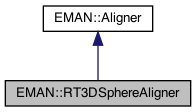3D rotational and translational alignment using spherical sampling, can reduce the search space based on symmetry. More...
#include <aligner.h>


Public Member Functions | |
| virtual EMData * | align (EMData *this_img, EMData *to_img, const string &cmp_name="sqeuclidean", const Dict &cmp_params=Dict()) const |
| See Aligner comments for more details. More... | |
| virtual EMData * | align (EMData *this_img, EMData *to_img) const |
| See Aligner comments for more details. More... | |
| virtual vector< Dict > | xform_align_nbest (EMData *this_img, EMData *to_img, const unsigned int nsoln, const string &cmp_name, const Dict &cmp_params) const |
| See Aligner comments for more details. More... | |
| virtual string | get_name () const |
| Get the Aligner's name. More... | |
| virtual string | get_desc () const |
| virtual TypeDict | get_param_types () const |
 Public Member Functions inherited from EMAN::Aligner Public Member Functions inherited from EMAN::Aligner | |
| virtual | ~Aligner () |
| virtual Dict | get_params () const |
| Get the Aligner parameters in a key/value dictionary. More... | |
| virtual void | set_params (const Dict &new_params) |
| Set the Aligner parameters using a key/value dictionary. More... | |
Static Public Member Functions | |
| static Aligner * | NEW () |
Static Public Attributes | |
| static const string | NAME = "rotate_translate_3d" |
Additional Inherited Members | |
 Protected Attributes inherited from EMAN::Aligner Protected Attributes inherited from EMAN::Aligner | |
| Dict | params |
Detailed Description
3D rotational and translational alignment using spherical sampling, can reduce the search space based on symmetry.
can also make use of different OrientationGenerators (random, for example) 2X more efficient than the RT3DGridAligner The aligner actually aligns the reference to the 'moving' and then takes the inverse of the resulting transform. This is necessary because, in the case of symmetry (i.e. not c1), the reference symmetry axis must be aligned to the EMAN2 symmetry axis, restricting the search space to the asymmetrical points on a sphere. We note that if the reference symmetry axis is not aligned to the EMAN2 symmetry axis, the best thing is to do a full search (i.e. specify sym='c1') unless you really know what you are doing!
- Parameters
-
sym The symmtery to use as the basis of the spherical sampling orietgen Advanced. The orientation generation strategy delta Angle the separates points on the sphere. This is exclusive of the 'n' paramater n An alternative to the delta argument, this is the number of points you want generated on the sphere dphi The angle increment in the phi direction lphi Lower bound for the phi direction uphi Upper bound for the phi direction dotrans Do a translational search search The maximum length of the detectable translational shift - if you supply this parameter you can not supply the maxshiftx, maxshifty or maxshiftz parameters. Each approach is mutually exclusive searchx The maximum length of the detectable translational shift in the x direction- if you supply this parameter you can not supply the maxshift parameters searchy The maximum length of the detectable translational shift in the y direction- if you supply this parameter you can not supply the maxshift parameters searchz The maximum length of the detectable translational shift in the z direction- if you supply this parameter you can not supply the maxshift parameters verbose Turn this on to have useful information printed to standard out
- Date
- Feb 2011
Member Function Documentation
◆ align() [1/2]
|
inlinevirtual |
See Aligner comments for more details.
Implements EMAN::Aligner.
Definition at line 1708 of file aligner.h.
References align().
◆ align() [2/2]
◆ get_desc()
|
inlinevirtual |
Implements EMAN::Aligner.
◆ get_name()
|
inlinevirtual |
◆ get_param_types()
|
inlinevirtual |
Implements EMAN::Aligner.
Definition at line 1733 of file aligner.h.
References EMAN::EMObject::BOOL, EMAN::EMObject::FLOAT, EMAN::EMObject::INT, EMAN::TypeDict::put(), EMAN::EMObject::STRING, and EMAN::EMObject::TRANSFORM.
◆ NEW()
|
inlinestatic |
◆ xform_align_nbest()
|
virtual |
See Aligner comments for more details.
Reimplemented from EMAN::Aligner.
Definition at line 4394 of file aligner.cpp.
References EMAN::EMData::calc_ccf(), calc_max_location_wrap_cuda(), EMAN::Cmp::cmp(), copy(), EMAN::Symmetry3D::gen_orientations(), EMAN::Factory< T >::get(), get_stats_cuda(), EMAN::Dict::has_key(), ImageDimensionException, InvalidParameterException, EMAN::Transform::invert(), EMAN::Aligner::params, CudaPeakInfo::peak, CudaPeakInfo::px, CudaPeakInfo::py, CudaPeakInfo::pz, EMAN::Dict::set_default(), EMAN::Transform::set_trans(), and sqrt().
Member Data Documentation
◆ NAME
|
static |
Definition at line 1753 of file aligner.h.
Referenced by get_name().
The documentation for this class was generated from the following files: